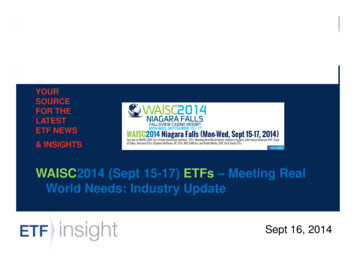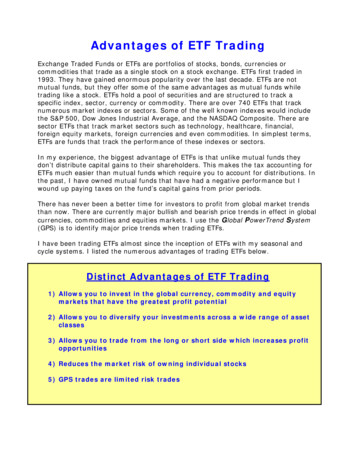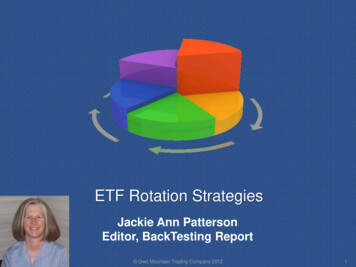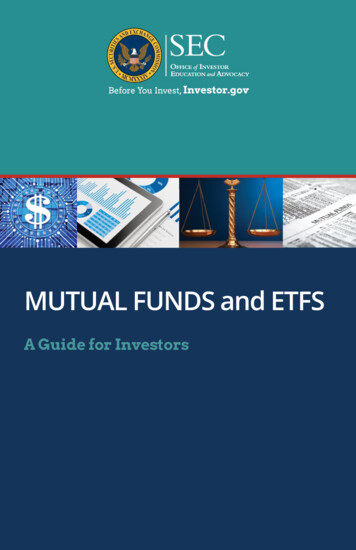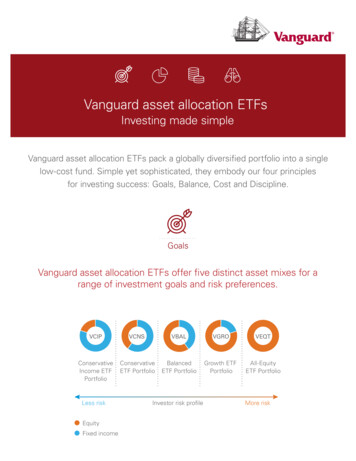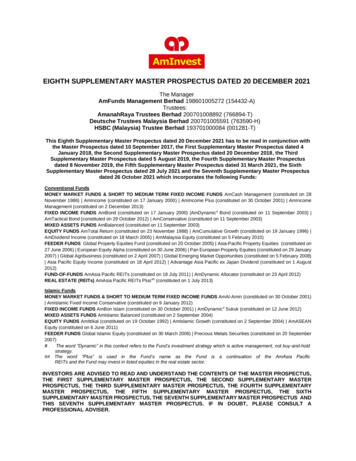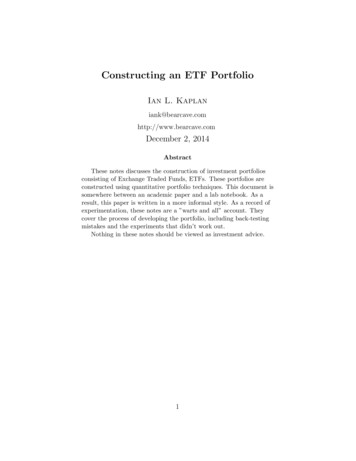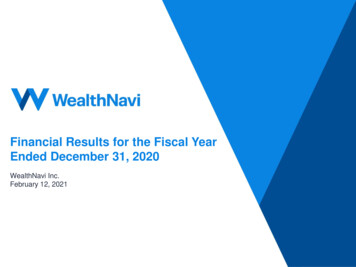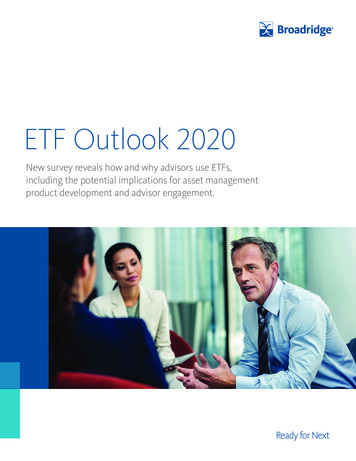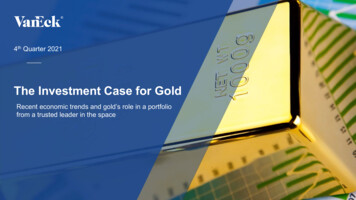
Transcription
Global X E-commerce ETFNASDAQ: EBIZProspectusOctober 17, 2018, as amended and restated November 20, 2018The Securities and Exchange Commission (“SEC”) has not approved or disapproved these securities or passed upon the adequacyof this Prospectus. Any representation to the contrary is a criminal offense.Shares in the Fund are not guaranteed or insured by the Federal Deposit Insurance Corporation or any other agency of the U.S.Government, nor are shares deposits or obligations of any bank. Such shares in the Fund involve investment risks, including theloss of principal.
TABLE OF CONTENTSFUND SUMMARY1ADDITIONAL INFORMATION ABOUT THE FUND10A FURTHER DISCUSSION OF PRINCIPAL RISKS11A FURTHER DISCUSSION OF OTHER RISKS26PORTFOLIO HOLDINGS INFORMATION27FUND MANAGEMENT27DISTRIBUTOR28BUYING AND SELLING FUND SHARES28FREQUENT TRADING30DISTRIBUTION AND SERVICE PLAN30DIVIDENDS AND DISTRIBUTIONS31TAXES35DETERMINATION OF NET ASSET VALUE36PREMIUM/DISCOUNT INFORMATION36INFORMATION REGARDING THE INDEX AND THE INDEX PROVIDER37OTHER SERVICE PROVIDERS37ADDITIONAL INFORMATION38FINANCIAL HIGHLIGHTS38OTHER INFORMATION38
Global X E-commerce ETFTicker: EBIZ Exchange: NASDAQINVESTMENT OBJECTIVEThe Global X E-commerce ETF (“Fund”) seeks to provide investment results that correspond generally to the price and yieldperformance, before fees and expenses, of the Solactive E-commerce Index (“Underlying Index”).FEES AND EXPENSESThis table describes the fees and expenses that you may pay if you buy and hold shares (“Shares”) of the Fund. You will alsoincur usual and customary brokerage commissions when buying and selling Shares.Annual Fund Operating Expenses (expenses that you pay each year as a percentage of the value of your investment):Management Fees:Distribution and Service (12b-1) Fees:Other Expenses:1Total Annual Fund Operating Expenses:10.68%None0.00%0.68%Other Expenses are based on estimated amounts for the current fiscal year.Example: The following example is intended to help you compare the cost of investing in the Fund with the cost of investing inother funds. This example does not take into account customary brokerage commissions that you pay when purchasing or sellingShares of the Fund in the secondary market. The example assumes that you invest 10,000 in the Fund for the time periodsindicated and then sell all of your Shares at the end of those periods. The example also assumes that your investment has a 5%return each year and that the Fund's operating expenses remain the same. Although your actual costs may be higher or lower,based on these assumptions, your costs would be:One Year 69Three Years 218Portfolio Turnover: The Fund pays transaction costs, such as commissions, when it buys and sells securities (or "turns over" itsportfolio). A higher portfolio turnover rate may indicate higher transaction costs and may result in higher taxes when Shares areheld in a taxable account. These costs, which are not reflected in annual fund operating expenses or in the example, affect theFund’s performance. This is a new fund and does not yet have a portfolio turnover rate to disclose.1
PRINCIPAL INVESTMENT STRATEGIESThe Fund invests at least 80% of its total assets in the securities of the Underlying Index. The Fund’s 80% investment policy isnon-fundamental and requires 60 days prior written notice to shareholders before it can be changed.The Underlying Index is designed to provide exposure to exchange-listed companies that are positioned to benefit from theincreased adoption of e-commerce as a distribution model, including but not limited to companies whose principal business is inoperating e-commerce platforms, providing e-commerce software and services, and/or selling goods and services online(collectively, “E-commerce Companies”), as defined by Solactive AG, the provider of the Underlying Index ("Index Provider").In constructing the Underlying Index, the Index Provider first applies a proprietary natural language processing algorithm to theeligible universe, which seeks to identify and rank companies with direct exposure to the e-commerce industry based on filings,disclosures and other public information (e.g. regulatory filings, earnings transcripts, etc.). Companies identified by the naturallanguage processing algorithm, as of the selection date, are further reviewed by the Index Provider on the basis of revenue relatedto e-commerce activities. To be eligible for the Underlying Index, a company is considered by the Index Provider to be an Ecommerce Company if the company generates at least 50% of its revenues from e-commerce activities, as determined by theIndex Provider. E-commerce Companies are those companies that (i) operate e-commerce platforms that connect buyers andsellers of goods and services via online marketplaces, (ii) provide e-commerce software, analytics or services that facilitate thedevelopment and enhancement of e-commerce platforms, and/or (iii) primarily sell goods and services online and generate themajority of their overall revenue from online retail, as determined by the Index Provider.To be a part of the eligible universe of the Underlying Index, certain minimum market capitalization and liquidity criteria, asdefined by the Index Provider, must be met. As of October 1, 2018, companies must have a minimum market capitalization of 200 million and a minimum average daily turnover for the last 6 months greater than or equal to 2 million in order to be eligiblefor inclusion in the Underlying Index. As of October 1, 2018, companies listed in the following countries were eligible forinclusion in the Underlying Index: Australia, Austria, Belgium, Brazil, Canada, Denmark, Finland, France, Germany, Hong Kong,Ireland, Israel, Italy, Japan, Netherlands, New Zealand, Norway, Poland, Portugal, Singapore, Spain, Sweden, Switzerland, SouthKorea, Taiwan, the United Kingdom, and the United States.The Underlying Index is weighted according to a modified capitalization weighting methodology and is reconstituted and reweighted semi-annually. Modified capitalization weighting seeks to weight constituents primarily based on market capitalization,but subject to caps on the weights of the individual securities. Generally speaking, this approach will limit the amount ofconcentration in the largest market capitalization companies and increase company-level diversification. The Underlying Indexmay include large-, mid- or small-capitalization companies, and components primarily include information technology andconsumer discretionary companies. As of October 1, 2018, the Underlying Index had 35 constituents. The Fund's investmentobjective and Underlying Index may be changed without shareholder approval.The Underlying Index is sponsored by the Index Provider, which is an organization that is independent of the Fund and Global XManagement Company LLC, the investment adviser for the Fund (“Adviser”). The Index Provider determines the relativeweightings of the securities in the Underlying Index and publishes information regarding the market value of the UnderlyingIndex.2
The Adviser uses a “passive” or indexing approach to try to achieve the Fund’s investment objective. Unlike many investmentcompanies, the Fund does not try to outperform the Underlying Index and does not seek temporary defensive positions whenmarkets decline or appear overvalued.The Fund generally will use a replication strategy. A replication strategy is an indexing strategy that involves investing in thesecurities of the Underlying Index in approximately the same proportions as in the Underlying Index. However, the Fund mayutilize a representative sampling strategy with respect to the Underlying Index when a replication strategy might be detrimentalor disadvantageous to shareholders, such as when there are practical difficulties or substantial costs involved in compiling aportfolio of equity securities to replicate the Underlying Index, in instances in which a security in the Underlying Index becomestemporarily illiquid, unavailable or less liquid, or as a result of legal restrictions or limitations (such as tax diversificationrequirements) that apply to the Fund but not the Underlying Index.The Adviser expects that, over time, the correlation between the Fund’s performance and that of the Underlying Index, beforefees and expenses, will exceed 95%. A correlation percentage of 100% would indicate perfect correlation.The Fund concentrates its investments (i.e., holds 25% or more of its total assets) in a particular industry or group of industriesto approximately the same extent that the Underlying Index is concentrated. Accordingly, the Fund's assets will be concentratedin companies that provide exposure to e-commerce. As of October 1, 2018, the Underlying Index also had significant exposureto the consumer discretionary and information technology sectors.SUMMARY OF PRINCIPAL RISKSAs with any investment, you could lose all or part of your investment in the Fund, and the Fund's performance could trail that ofother investments. There is no guarantee that the Fund will achieve its investment objective. The Fund is subject to the principalrisks noted below, any of which may adversely affect the Fund's net asset value ("NAV"), trading price, yield, total return andability to meet its investment objective, as well as other risks that are described in greater detail in the Additional InformationAbout the Fund section of this Prospectus and in the Statement of Additional Information ("SAI").Asian Economic Risk: Investments in Asian markets involve risks not typically associated with investments in securities ofissuers in more developed countries, which may negatively affect the value of your investment in the Fund. The countries in Asiapresent different economic and political conditions from those in Western markets, and less social, political and economicstability. Political instability could have an adverse effect on economic or social conditions in these economies and may result inoutbreaks of civil unrest, terrorist attacks or threats or acts of war in the affected areas, any of which could materially and adverselyaffect the companies in which the Fund may invest.Asset Class Risk: Securities in the Underlying Index or otherwise held in the Fund's portfolio may underperform in comparisonto the general securities markets or other asset classes.3
Asset Fluctuation Risk: Certain shareholders, including an Authorized Participant (as defined in the SAI), the Adviser or anaffiliate of the Adviser, may own a substantial amount of the Fund’s Shares. Additionally, from time to time an AuthorizedParticipant, a third party investor, the Adviser, or an affiliate of the Adviser may invest in the Fund and hold its investment for aspecific period of time in order to facilitate commencement of the Fund’s operations or to allow the Fund to achieve size orscale. Redemptions by large shareholders could have a significant negative impact on the Fund. If a large shareholder were toredeem all, or a large portion, of its Shares, there is no guarantee that the Fund will be able to maintain sufficient assets to continueoperations, in which case the Board of Trustees may determine to liquidate the Fund. In addition, transactions by largeshareholders may account for a large percentage of the trading volume on the NASDAQ (the “Exchange”) and may, therefore,have a material upward or downward effect on the market price of the Shares.Authorized Participant Concentration Risk: The Fund has a limited number of financial institutions that may act as AuthorizedParticipants. Only Authorized Participants who have entered into agreements with the Fund’s distributor may engage in creationor redemption transactions directly with the Fund. To the extent that those Authorized Participants exit the business or are unableto process creation and/or redemption orders, and no other Authorized Participant is able to step forward to create or redeem ineither of those cases, Shares may be more likely to trade at a premium or discount to NAV and possibly face trading halts and/ordelisting from a securities exchange. Authorized Participant Concentration Risk may be heightened because the Fund invests innon-U.S. securities.Concentration Risk: Because the Fund's investments are concentrated in the consumer discretionary sector, the Fund will besusceptible to loss due to adverse occurrences affecting this sector or industry. To the extent that the Underlying Index concentratesin the securities of issuers in a particular country, industry, market, asset class, or sector, the Fund will also concentrate itsinvestments to approximately the same extent. By concentrating its investments in a country, industry, market, asset class, orsector, the Fund faces more risks than if it were diversified broadly over numerous countries, industries, markets, asset classes,or sectors. Such risks, any of which may adversely affect the companies in which the Fund invests, may include, but are notlimited to, the following: general economic conditions or cyclical market patterns that could negatively affect supply and demand;competition for resources; adverse labor relations; political or world events; obsolescence of technologies; and increasedcompetition or new product introductions that may affect the profitability or viability of companies in a particular country,industry, market, asset class, or sector. In addition, at times, such country, industry, market, asset class, or sector may be out offavor and underperform other similar categories or the market as a whole. For additional details on these risks, please see RisksRelated to Investing in the Consumer Discretionary Sector and Risks Related to Investing in the Information TechnologySector.Currency Risk: The Fund may invest in securities denominated in foreign currencies. Because the Fund's NAV is determined inU.S. dollars, the Fund's NAV could decline if the relevant foreign currencies depreciate against the U.S. dollar or if there aredelays or limits on repatriation of such currency. Currency exchange rates can be very volatile and can change quickly andunpredictably. As a result, the Fund's NAV may change quickly and without warning, which could have a significant negativeimpact on the Fund.Custody Risk: Less developed markets are more likely to experience problems with the clearing and settling of trades and theholding of securities by local banks, agents and depositories.4
Cyber Security Risk: Failures or breaches of the electronic systems of the Fund, the Adviser, and the Fund's other serviceproviders, market makers, Authorized Participants or the issuers of securities in which the Fund invests have the ability to causedisruptions and negatively impact the Fund's business operations, potentially resulting in financial losses to the Fund and itsshareholders. While the Fund has established business continuity plans and risk management systems seeking to address systembreaches or failures, there are inherent limitations in such plans and systems. Furthermore, the Fund cannot control the cybersecurity plans and systems of the Fund's service providers, market makers, Authorized Participants or issuers of securities inwhich the Fund invests.Emerging Markets Risk: The Fund is expected to invest in securities in emerging market countries. The Fund’s investment inan emerging market country may be subject to a greater risk of loss than investments in developed markets. Securities markets ofemerging market countries are less liquid, subject to greater price volatility, have smaller market capitalizations, have lessgovernment regulation, and are not subject to as extensive and frequent accounting, financial, and other reporting requirementsas the securities markets of more developed countries. Because certain securities markets in the emerging market countries inwhich the Fund may invest are small in size, underdeveloped and are less regulated and less correlated to global economic cyclesthan those markets located in more developed countries, the securities markets in such countries are subject to greater risksassociated with market volatility, lower market capitalization, lower trading volume, illiquidity, inflation, greater pricefluctuations and uncertainty regarding the existence of trading markets.Equity Securities Risk: Equity securities are subject to changes in value and their values may be more volatile than other assetclasses, as a result of such factors as a company’s business performance, investor perceptions, stock market trends and generaleconomic conditions.European Economic Risk: Decreasing European imports, new trade regulations, changes in exchange rates, a recession inEurope, or a slowing of economic growth in this region could have an adverse impact on the securities in which the Fund invests.Foreign Securities Risk: The Fund's investments in foreign securities can be riskier than U.S. securities investments. Investmentsin the securities of foreign issuers (including investments in American Depository Receipts ("ADRs") and Global DepositoryReceipts ("GDRs") are subject to the risks associated with investing in those foreign markets, such as heightened risks of inflationor nationalization. The prices of foreign securities and the prices of U.S. securities have, at times, moved in opposite directions.In addition, securities of foreign issuers may lose value due to political, economic and geographic events affecting a foreign issueror market. During periods of social, political or economic instability in a country or region, the value of a foreign security tradedon U.S. exchanges could be affected by, among other things, increasing price volatility, illiquidity, or the closure of the primarymarket on which the security (or the security underlying the ADR or GDR) is traded. You may lose money due to political,economic, and geographic events affecting a foreign issuer or market.Geographic Risk: A natural disaster could occur in a geographic region in which the Fund invests, which could affect theeconomy or particular business operations of companies in the specific geographic region, causing an adverse impact on theFund’s investments in the affected region or in a region economically tied to the affected region.5
Index-Related Risk: There is no guarantee that the Fund will achieve a high degree of correlation to the Underlying Index andtherefore achieve its investment objective. Market disruptions and regulatory restrictions could have an adverse effect on theFund’s ability to adjust its exposure to the required levels in order to track the Underlying Index. Errors in index data, indexcomputations and/or the construction of the Underlying Index in accordance with its methodology may occur from time to timeand may not be identified and corrected by the Index Provider for a period of time or at all, which may have an adverse impacton the Fund and its shareholders.International Closed Market Trading Risk: To the extent that the underlying securities held by the Fund trade on foreignexchanges that may be closed when the securities exchange on which the Fund’s Shares trade is open, there are likely to bedeviations between the current price of such an underlying security and the last quoted price for the underlying security (i.e., theFund’s quote from the closed foreign market). These deviations could result in premiums or discounts to the Fund’s NAV thatmay be greater than those experienced by other exchange-traded funds ("ETFs").Issuer Risk: Fund performance depends on the performance of individual companies in which the Fund invests. Changes to thefinancial condition of any of those companies may cause the value of their securities to decline.Large-Capitalization Companies Risk: Large-capitalization companies may trail the returns of the overall stock market. Largecapitalization stocks tend to go through cycles of doing better - or worse - than the stock market in general. These periods have,in the past, lasted for as long as several years.Listing Standards Risk: Under continuous listing standards adopted by the Fund’s listing exchange, the Fund will be requiredto confirm on an ongoing basis that the components of the Underlying Index satisfy the applicable listing requirements. In theevent that the Underlying Index does not comply with the applicable listing requirements, the Fund would be required to rectifysuch non-compliance by requesting that the Index Provider modify the Underlying Index, adopting a new underlying index, orobtaining relief from the SEC. Failure to rectify such non-compliance may result in the Fund being delisted by the listingexchange.Management Risk: The Fund is subject to the risk that the Adviser’s investment management strategy may cause the Fund tounderperform the market or its relevant benchmark or adversely affect the ability of the Fund to achieve its investment objective.Market Risk: Turbulence in the financial markets and reduced liquidity may negatively affect issuers, which could have anadverse effect on the Fund. In addition, there is a risk that policy changes by the U.S. Government, Federal Reserve, or othergovernment actors, which could include increasing interest rates, could cause increased volatility in financial markets and lead tohigher levels of Fund redemptions, which could have a negative impact on the Fund. The Fund’s NAV could decline over shortperiods due to short-term market movements and over longer periods during market downturns.Market Trading Risk: Shares of the Fund are publicly traded on a national securities exchange which may subject shareholdersto numerous market trading risks, including the potential lack of an active market for Shares, losses from trading in secondarymarkets, periods of high volatility and disruption in the creation/redemption process of the Fund. Any of these factors may leadto the Shares trading at a premium or discount to NAV.6
Mid-Capitalization Companies Risk: Mid-capitalization companies may have greater price volatility, lower trading volume andless liquidity than large-capitalization companies. In addition, mid-capitalization companies may have smaller revenues, narrowerproduct lines, less management depth and experience, smaller shares of their product or service markets, fewer financial resourcesand less competitive strength than large-capitalization companies.Nationalization Risk: Investments in China may be subject to loss due to expropriation or nationalization of assets and propertyor the imposition of restrictions on foreign investments and repatriation of capital.New Fund Risk: The Fund is a new fund, with no operating history, which may result in additional risks for investors in theFund. There can be no assurance that the Fund will grow to or maintain an economically viable size, in which case the Board ofTrustees may determine to liquidate the Fund. While shareholder interests will be the paramount consideration, the timing of anyliquidation may not be favorable to certain individual shareholders. New funds are also subject to Asset Fluctuation Risk.Non-Diversification Risk: The Fund is classified as a “non-diversified” investment company under the Investment CompanyAct of 1940 ("1940 Act"). As a result, the Fund is subject to the risk that it may be more volatile than a diversified fund becausethe Fund may invest its assets in a smaller number of issuers or may invest a larger proportion of its assets in a single issuer. Asa result, the gains and losses on a single investment may have a greater impact on the Fund’s NAV and may make the Fund morevolatile than more diversified funds.Operational Risk: The Fund is exposed to operational risk arising from a number of factors, including but not limited to humanerror, processing and communication errors, errors of the Fund's service providers, counterparties or other third-parties, failed orinadequate processes and technology or systems failures. The Fund and the Adviser seek to reduce these operational risks throughcontrols and procedures. However, these measures do not address every possible risk and may be inadequate for those risks thatthey are intended to address.Passive Investment Risk: The Fund is not actively managed and the Adviser does not attempt to take defensive positions indeclining markets. Unlike many investment companies, the Fund does not seek to outperform its Underlying Index. Therefore, itwould not necessarily buy or sell a security unless that security is added or removed, respectively, from the Underlying Index,even if that security generally is underperforming. Maintaining investments in securities regardless of market conditions or theperformance of individual securities could cause the Fund’s return to be lower than if the Fund employed an active strategy.Premium/Discount Risk: Disruptions to creations and redemptions, the existence of extreme market volatility or potential lackof an active trading market for Shares may result in Shares trading at a significant premium or discount to NAV. If a shareholderpurchases Shares at a time when the market price is at a premium to the NAV or sells Shares at a time when the market price isat a discount to the NAV, the shareholder may sustain losses.Reliance on Trading Partners Risk: The Fund invests in the Chinese economy, which is heavily dependent upon trading withkey partners. Any reduction in this trading, including as a result of adverse economic conditions in a trading partner’s economy,7
may cause an adverse impact on the Chinese economy in which the Fund invests. Through its portfolio companies' tradingpartners, the Fund is specifically exposed to Asian Economic Risk and U.S. Economic Risk.Risk of Investing in Developed Countries: The Fund’s investment in a developed country issuer may subject the Fund toregulatory, political, currency, security, economic and other risks associated with developed countries. Developed countries tendto represent a significant portion of the global economy and have generally experienced slower economic growth than some lessdeveloped countries. In addition, developed countries may be impacted by changes to the economic conditions of certain keytrading partners, regulatory burdens, debt burdens and the price or availability of certain commodities.Risks Related to Investing in China: Investment exposure to China subjects the Fund to risks specific to China. China may besubject to considerable degrees of economic, political and social instability. China is an emerging market and demonstratessignificantly higher volatility, from time to time, in comparison to developed markets. Over the past 25 years, the Chinesegovernment has undertaken reform of economic and market practices and expansion of the sphere for private ownership ofproperty in China. However, Chinese markets generally continue to experience inefficiency, volatility and pricing anomaliesresulting from governmental influence, a lack of publicly available information and/or political and social instability. Internalsocial unrest or confrontations with other neighboring countries, including military conflicts in response to such events, may alsodisrupt economic development in China and result in a greater risk of currency fluctuations, currency convertibility, interest ratefluctuations and higher rates of inflation. Export growth continues to be a major driver of China’s rapid economic growth.Reduction in spending on Chinese products and services, institution of tariffs or other trade barriers, or a downturn in any of theeconomies of China’s key trading partners may have an adverse impact on the Chinese economy. The 2016 presidential electionin the U.S. may have increased the probability of new trade regulations and other protective trade measures being implementedin relation to China. While policy implications remain uncertain, new regulations or trade barriers could lead to a decrease intrade activity between China and the U.S., which could have an adverse impact on the Chinese economy. China has implementeda number of tax reforms in recent years, and may amend or revise its existing tax laws and/or procedures in the future, possiblywith retroactive effect. Changes in applicable Chinese tax law could reduce the after-tax profits of the Fund, directly or indirectly,including by reducing the after-tax profits of companies in China in which the Fund invests. Uncertainties in Chinese tax rulescould result in unexpected tax liabilities for the Fund.Risks Related to Investing in the Consumer Discretionary Sector: The consumer discretionary sector may be affected bychanges in domestic and international economies, exchange and interest rates, competition, consumers’ disposable income andconsumer preferences, social trends and marketing campaigns.Risks Related to Investing in E-commerce Companies: E-commerce Companies typically face intense competition and aresubject to fluctuating consumer demand. Many of these companies compete aggressively on price, potentially affecting their longrun profitability. Due to the online nature of E-commerce Companies and their involvement in processing, storing and transmittinglarge amounts of data, these companies are particularly vulnerable to cyber security risk. This includes threats to operationalsoftware and hardware, as well as theft of personal and transaction records and other customer data. In the event of a cyberattack,E-commerce Companies could suffer serious adverse reputational and operational consequences, including liability and litigation.8
Risks Related to Investing in the Information Technology Sector: Companies in the information technology sector are subjectto rapid changes in technology product cycles; rapid product obsolescence; government regulation; and increased competition,both domestically and internationally, including competition from foreign competitors with lower production costs. Informationtechnolo
NASDAQ: EBIZ Prospectus October 17, 2018, as amended and restated November 20, 2018 . (such as tax diversification requirements) that apply to the Fund but not the Underlying Index. The Adviser expects that, over time, the correlation between the Fund's performance and that of the Underlying Index, before fees and expenses, will exceed 95% .
